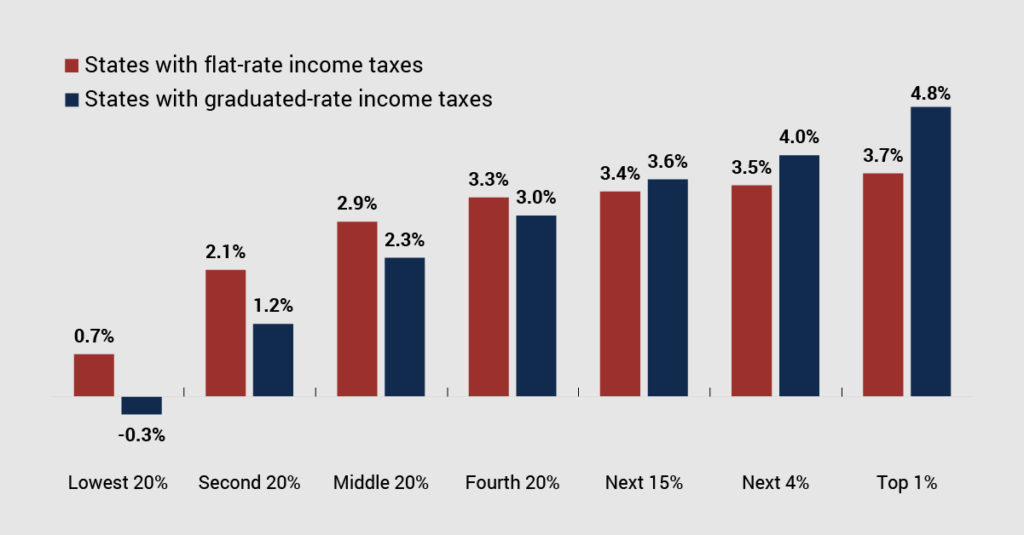The word “tax” appears 97 times and counting in one recent summary of governors’ addresses to state legislators so far this year. The policy visions that governors are bringing, however, vary enormously. While there’s good reason to worry about tax cuts for wealthy families and the flattening or elimination of income taxes, there are at least five great tax ideas coming directly out of governors’ offices this year, to add to exciting ideas from legislators we’ve previously described.
Tax Income from Wealth with Higher Rates on Capital Gains
Wisconsin Gov. Tony Evers and Minnesota Gov. Tim Walz are each seeking to raise taxes on wealthy families profiting from their investments by charging higher rates on realized capital gains income. In Wisconsin, Gov. Evers wants to scale back a carveout that lets investors shelter 30 percent of their long-term capital gains income from tax. Under Evers’ proposal, individuals with income over $400,000 (or $533,000 for married couples) would no longer benefit from this subsidy. In Minnesota, Gov. Walz hopes to go one step further by taxing capital gains at a somewhat higher rate than other forms of income. Capital gains and dividends over $1 million would face a 4 percent surcharge while gains between $500,000 and $1 million would face a 1.5 percent surcharge under Walz’s plan. Our policy brief discussing capital gains taxes points out that this income overwhelmingly flows to a small number of wealthy, white families and recommends higher state tax rates on capital gains as a way of advancing greater overall parity in the taxation of wealth versus work.
Bolster Family Economic Security with Tax Credits
One of the clearest trends in state tax debates this year is the continuing momentum toward new and better tax credits for workers and families. Proven policies like Child Tax Credits (CTCs) and Earned Income Tax Credits (EITCs) have immense potential to curb inequities in state tax laws while setting up the next generation of Americans to succeed. To that end, Massachusetts Gov. Maura Healey is proposing a $600 refundable CTC and has expressed interest in expanding the state’s EITC as well. But the list of governors interested reforming the CTC, EITC, or both is a long one that also includes Arizona Gov. Katie Hobbs, Connecticut Gov. Ned Lamont, Delaware Gov. John Carney, Hawaii Gov. Josh Green, Maryland Gov. Wes Moore, Michigan Gov. Gretchen Whitmer, Minnesota Gov. Tim Walz, Montana Gov. Greg Gianforte, Vermont Gov. Phil Scott, and Wisconsin Gov. Tony Evers.
Crack Down on Aggressive Tax Avoidance Via Trusts
California Gov. Gavin Newsom is proposing that the state follow New York’s example by closing a tax loophole that wealthy families use to shift their income into tax haven states without personal income taxes on trust income. At issue are INGs, or incomplete nongrantor trusts, which tax advisors have promoted for more than a decade as a means of dodging state income tax on stocks, bonds, and certain other business income. The Center on Budget and Policy Priorities recently released a report explaining the importance of closing this loophole.
Tax Profitable Corporations
New York Gov. Kathy Hochul and Connecticut Gov. Ned Lamont are each proposing to extend temporary surcharges applied to their states’ corporate income taxes. (Unfortunately, New Jersey Gov. Phil Murphy is sounding a different note on that state’s temporary surcharge.) Connecticut’s surcharge expired on January 1st while New York’s is set to expire at the end of this year. While this is welcome news, ideally Connecticut, New York, and every other state with a corporate income tax would undertake a more ambitious corporate tax reform known as worldwide combined reporting. This is the best and most comprehensive way for states to stop corporations from avoiding taxes by artificially shifting their profits, on paper, into lower-tax states and countries.
Fund Paid Family and Medical Leave
Minnesota Gov. Tim Walz is proposing to join 11 other states in creating a state-administered system of paid family and medical leave that would allow workers to take up to 12 weeks off work to care for themselves or a loved one. These benefits would be funded through a payroll tax levied at a rate likely to be roughly 0.7 percent. The U.S. lags far behind most other countries in offering these kinds of benefits for new parents and those confronting illness, and with no signs of a federal reform on the immediate horizon there is even more reason for states to make progress on this front.
Leading by Example
While many of the tax ideas being floated by governors this year would move state tax systems in a less equitable and less sustainable direction, these positive, visionary proposals would set states on a better path. Reworking state and local tax codes to ask more of the wealthy families and corporations that most Americans think pay too little, bolstering family economic security with tax credits, and funding critical priorities like family and medical leave are all ideas that would strengthen our states and our nation.





